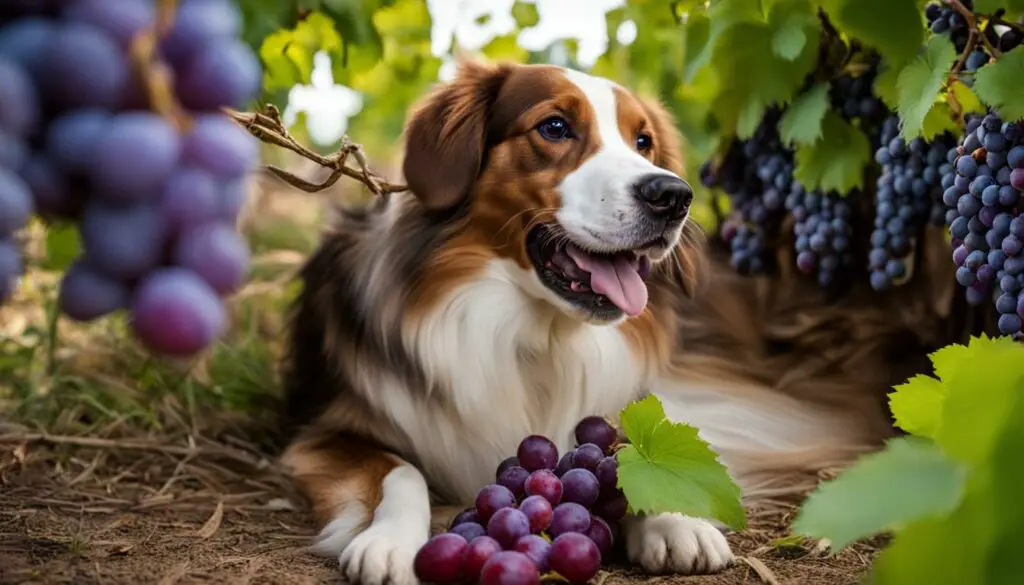Grapes are a delicious and healthy snack for humans, but did you know that they can be extremely toxic to dogs? If your furry friend has accidentally eaten a grape, it’s crucial to take immediate action to protect their health. In this article, I will discuss the potential dangers of grape toxicity in dogs, the symptoms to watch out for, and the steps you can take to prevent grape ingestion.
Key Takeaways:
- Grapes and grape-containing products, such as raisins and grape juice, are toxic to dogs.
- Symptoms of grape poisoning in dogs include loss of appetite, vomiting, diarrhea, weakness, and increased urination.
- If your dog ingests grapes, contact your veterinarian or a pet poison helpline for guidance.
- Prevent grape toxicity by keeping grapes out of your dog’s reach and avoiding sharing grape-containing food with them.
- Prompt action is essential to prevent kidney damage and failure from grape ingestion.
Why Are Grapes Toxic to Dogs?
Grapes are highly toxic to dogs, but the exact reason behind their toxicity is still not fully understood. Researchers speculate that substances like tartaric acid or mycotoxin produced by mold or fungus may be responsible for the harmful effects of grapes on dogs. These compounds can lead to kidney damage and failure in canines.
All types of grapes, including red, green, purple, seeded, and seedless varieties, as well as grape juice, wine, raisins, and currants, are toxic to dogs. It’s important to note that even a single grape can be dangerous for a dog, so pet owners should be vigilant in keeping these fruits away from their furry companions.

Prevention is key in protecting dogs from grape toxicity. Pet owners should ensure that grapes and grape-containing products are securely stored in a place where dogs cannot access them. It’s also essential to check food ingredients for grapes or grape juice before sharing any human food with dogs. By taking these precautions, pet owners can help keep their dogs safe and avoid the potential health risks associated with grape ingestion.
Related: Foods Toxic to Dogs
In addition to grapes, there are other human foods that can be toxic to dogs. Some examples include:
- Onions and garlic
- Chocolate
- Alcohol
- Macadamia nuts
- Foods with xylitol
It’s important for dog owners to be aware of these foods and take measures to prevent accidental ingestion by their pets. By keeping these dangerous foods out of reach and ensuring a safe environment, pet owners can protect their dogs from potential toxicity.
What to Do If Your Dog Ate One Grape
If you find yourself in the unfortunate situation where your dog has eaten a grape, it is important to take immediate action to minimize the potential harm. Remember, even a single grape can be toxic to dogs and can lead to kidney damage and failure. Here are the steps you should take:
- Contact your veterinarian: Reach out to your veterinarian or a pet poison helpline right away for guidance on what to do next. They will be able to provide you with specific advice based on your dog’s size, breed, and any pre-existing health conditions.
- Monitor for symptoms: Keep a close eye on your dog for any signs of grape poisoning, such as loss of appetite, vomiting, diarrhea, weakness, and increased urination. If any of these symptoms occur, it is crucial to seek immediate veterinary attention.
- Follow professional advice: Your veterinarian may recommend inducing vomiting if it is within a certain timeframe and safe to do so. However, never attempt to induce vomiting without consulting a professional first, as it can be dangerous in some cases. Always follow the guidance of your veterinarian or a pet poison helpline.
Remember, time is of the essence when it comes to grape ingestion in dogs. Acting quickly and seeking professional advice can help prevent potential kidney damage and increase the chances of a positive outcome for your furry friend.
| Emergency Vet Contact Information | Pet Poison Helpline |
|---|---|
| Phone: 123-456-7890 | Phone: 987-654-3210 |
| Address: 123 Main Street | Address: 456 Elm Avenue |
Note: Remember to always consult with your veterinarian or a pet poison helpline for guidance tailored to your specific situation. The information provided here is for general knowledge and should not replace professional advice.
Signs of Grape Poisoning in Dogs

Dogs can show various signs of grape poisoning, which can vary in severity depending on the amount of grapes consumed and the individual dog’s sensitivity. It is important for dog owners to be vigilant of these signs and seek immediate veterinary attention if they suspect their dog has ingested grapes or grape-containing products. The following are common signs of grape poisoning in dogs:
- Loss of appetite
- Drinking a lot initially
- Diarrhea
- Vomiting
- Abdominal pain
- Weakness
- Lethargy
- Bad breath
- Increased urination followed by decreased urine production
- Dehydration
These symptoms typically appear between 12 and 24 hours after ingestion and can persist for several days. If you notice any of these signs in your dog, it is crucial to contact your veterinarian immediately or visit a 24/7 animal hospital for immediate treatment.
Early recognition and prompt veterinary intervention are key in managing grape poisoning in dogs and minimizing the risk of kidney damage and failure. Remember, grape poisoning is a serious condition, and even a small amount of grapes can be toxic to a dog. It is always better to be safe and seek professional help to ensure the well-being of your furry friend.
How Your Vet Will Treat Grape Poisoning
If your dog is diagnosed with grape poisoning, prompt treatment is crucial to prevent further complications. The treatment plan will depend on the severity of the poisoning and the state of your dog’s health.
One common method of treatment is inducing vomiting to remove any remaining grapes from your dog’s stomach. This is typically done under the supervision of a veterinarian using medications or hydrogen peroxide. Activated charcoal may also be administered to prevent the absorption of toxins into your dog’s bloodstream.
In addition, your veterinarian may provide fluid therapy to help flush out the toxins and protect the kidneys. This involves administering fluids intravenously to maintain hydration and support kidney function. Your vet may also run blood tests to monitor kidney function and determine the best course of action.
It’s important to note that the treatment for grape poisoning in dogs should always be provided by a professional. Never attempt to induce vomiting or administer any medications without consulting a veterinarian first.
| Treatment for Grape Poisoning in Dogs | Description |
|---|---|
| Inducing Vomiting | The veterinarian may use medications or hydrogen peroxide to induce vomiting and remove any grapes from the stomach. |
| Activated Charcoal | Administering activated charcoal can help prevent the absorption of toxins into the bloodstream. |
| Fluid Therapy | Fluids are administered intravenously to maintain hydration and support kidney function. |
| Blood Tests | Blood tests may be conducted to monitor kidney function and determine the best course of treatment. |
When to Seek Emergency Treatment
If your dog is experiencing severe symptoms such as vomiting, diarrhea, lethargy, or difficulty urinating, it is crucial to seek emergency veterinary care immediately. Kidney failure can be life-threatening, and timely intervention can greatly improve your dog’s chances of recovery.
Remember, prevention is always better than treatment when it comes to grape poisoning. Keep grapes and grape-containing products out of your dog’s reach, and be cautious about sharing human food that may contain grapes. By being proactive in protecting your dog’s health, you can help ensure their safety and well-being.
Preventing Grape Poisoning in Dogs
When it comes to keeping our furry friends safe, prevention is key. To prevent grape toxicity in pets, pet owners should take a few simple yet important precautions. First and foremost, it is essential to keep grapes and grape-containing products out of reach of dogs. Place them in a safe place where your furry friend cannot access them, such as a locked cabinet or a high shelf. If you have children in the household, educate them about the dangers of grapes for dogs to avoid any accidental ingestion.
Additionally, it is crucial to check food ingredients for grapes or grape juice before sharing any human food with your dog. Many of our favorite foods contain grapes or grape-derived products, which can pose a serious threat to our canine companions. By diligently checking food labels, you can ensure that your dog avoids any potential exposure to grapes.
Awareness and caution are crucial in preventing grape toxicity in dogs. By following these simple steps and being proactive in safeguarding your pet’s well-being, you can significantly reduce the risk of grape ingestion and potential complications. Remember, your dog’s health is in your hands, so take the necessary precautions to keep them safe and healthy!
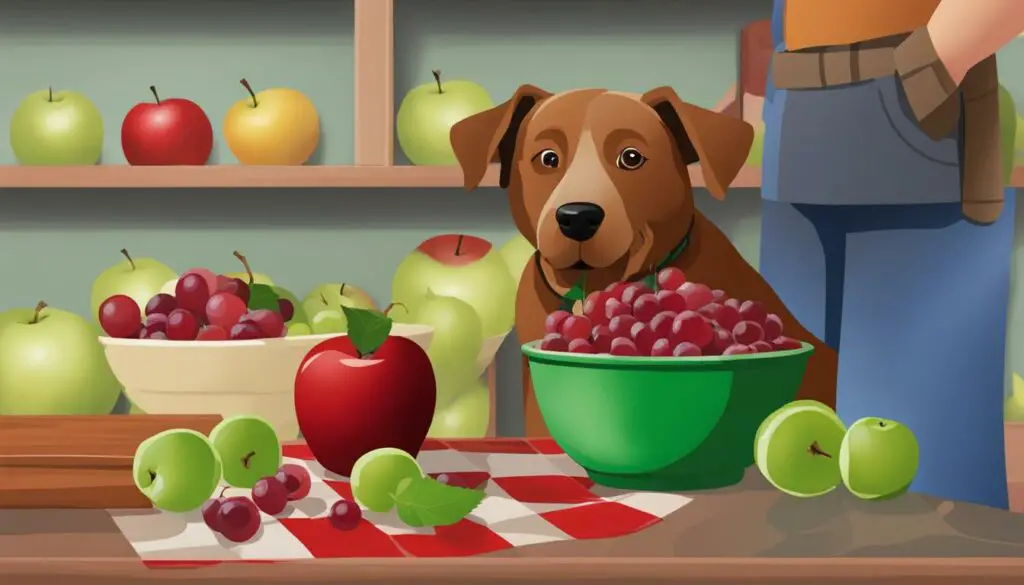
Table: Foods that are Toxic to Dogs
| Foods | Toxicity Level |
|---|---|
| Onions | High |
| Chocolate | High |
| Garlic | High |
| Alcohol | High |
| Cocoa | High |
| Macadamia nuts | High |
| Foods with xylitol | High |
| Grapes | High |
Table: Foods that are toxic to dogs. It is important to be aware of other foods that can be harmful to our dogs. Onions, chocolate, garlic, alcohol, cocoa, macadamia nuts, foods with xylitol, and, of course, grapes are just a few examples. By familiarizing ourselves with these toxic foods and ensuring they are kept out of our dogs’ reach, we can protect them from potential harm.
My Dog Ate Grapes But Seems Fine. Can Dogs Recover From Eating Grapes?
If your dog has ingested grapes and is currently showing no symptoms of grape poisoning, it is natural to wonder if they can recover without any complications. While every case is different, it is possible for dogs to recover from eating grapes, especially if immediate action is taken and the amount ingested is small.
However, it is important to note that the outcome of grape ingestion can vary depending on several factors. These include the amount of grapes consumed, the speed of treatment, the individual dog’s sensitivity to grapes, and whether or not kidney failure develops. Dogs have different levels of sensitivity to grapes, and even a small quantity can be toxic for some.
To maximize the chances of a favorable outcome, it is crucial to seek veterinary attention as soon as possible. Even if your dog seems fine initially, it is best to have them evaluated by a professional to rule out any potential complications. The veterinarian may recommend monitoring for symptoms of grape poisoning or taking precautionary measures such as inducing vomiting under their guidance.
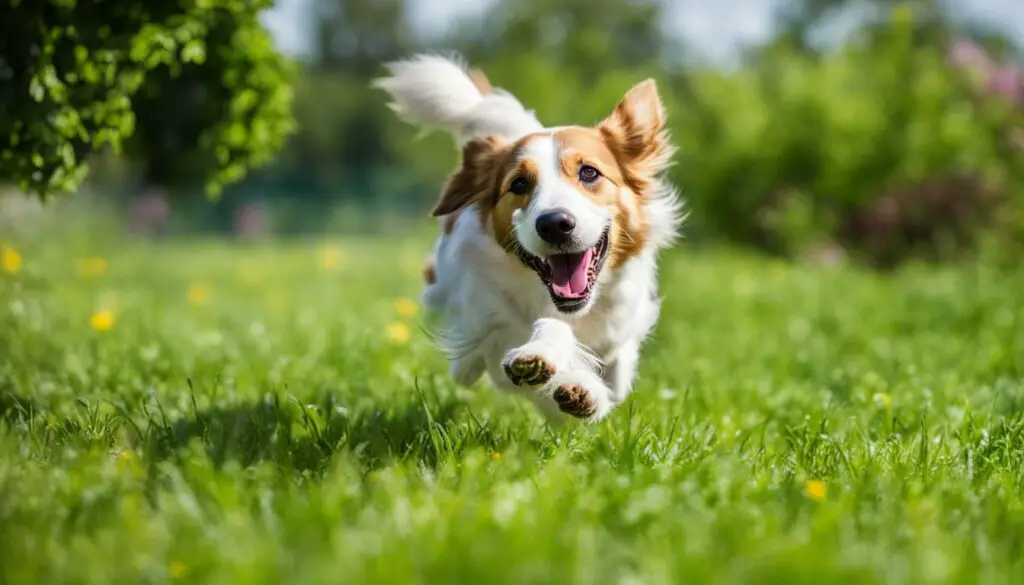
In cases where kidney damage or failure occurs, the dog’s chances of recovery may be slim. Unlike some organs in the body, the kidneys cannot regenerate or repair themselves, making the damage irreversible. This is why prompt action and early detection are crucial in ensuring the best possible outcome for your furry friend.
Overall, while it is possible for dogs to recover from eating grapes, it is always best to take any ingestion of grapes seriously and seek professional help. By acting quickly and responsibly, you can help protect your pet’s health and minimize the risks associated with grape toxicity.
What Other Foods Are Toxic to Dogs?
While grapes are known to be toxic to dogs, there are other human foods that can also be dangerous for our furry friends. It’s important for pet owners to be aware of these foods and take precautions to keep them away from their dogs. Here are some common foods that can be toxic to dogs:
| Food | Toxic Component |
|---|---|
| Onions | Sulfur compounds |
| Chocolate | Theobromine |
| Garlic | Sulfur compounds |
| Alcohol | Ethanol |
| Cocoa | Theobromine |
| Macadamia Nuts | Unknown |
| Foods with Xylitol | Xylitol |
These foods can cause various health problems in dogs, ranging from gastrointestinal upset to organ failure. It’s important to keep them out of your dog’s reach and avoid sharing them as treats or snacks. If you suspect your dog has ingested any of these toxic foods, contact your veterinarian immediately for guidance.
Remember, prevention is key when it comes to keeping our dogs safe. Always be mindful of what foods are harmful to dogs and take the necessary steps to ensure their well-being.
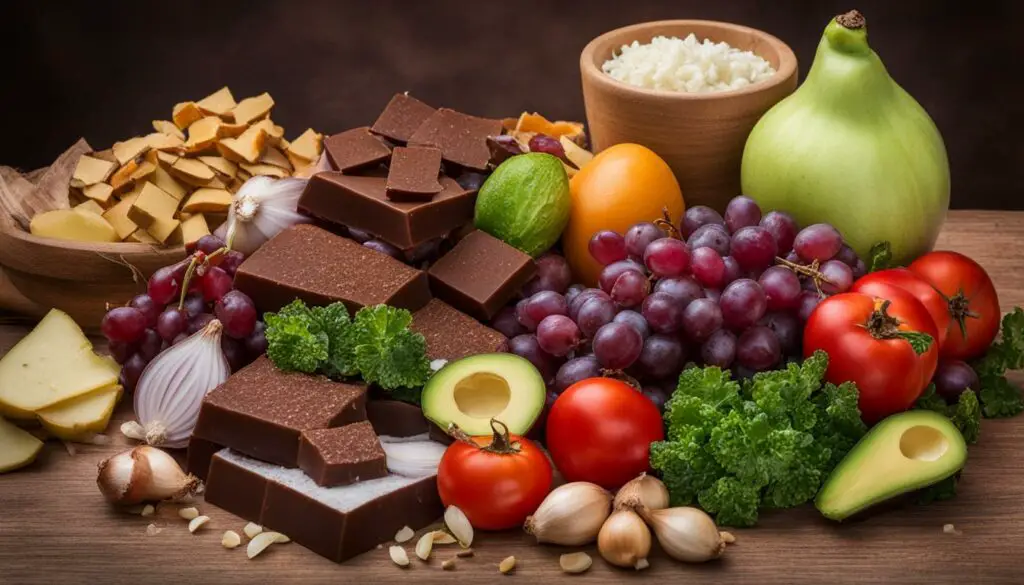
Protecting Your Pet’s Health
As responsible pet owners, it is our duty to protect our pets’ health and well-being. This includes being aware of foods that can be toxic to dogs and taking steps to prevent their ingestion. Here are some tips to help you protect your pet:
- Keep toxic foods, such as grapes, onions, chocolate, and alcohol, out of your dog’s reach.
- Check food labels for potentially harmful ingredients and avoid sharing human food with your dog.
- Educate yourself and your family members, especially children, about the dangers of certain foods for dogs.
- Consider pet insurance to provide financial support for emergency treatment and veterinary care.
By taking these precautions, you can help ensure the safety and well-being of your beloved canine companion.
What Fruits Can Dogs Eat?
While it’s important to be cautious of the fruits that can be toxic to dogs, there are actually several fruits that are safe and can provide nutritional benefits to our furry friends. When offering fruits to your dog, it’s essential to do so in moderation and monitor their reaction. Here are some fruits that are generally safe for dogs:
- Apples (without the seeds): Apples are a good source of vitamins A and C, as well as fiber. Remove the seeds and core before giving them to your dog to avoid any choking hazards.
- Bananas: Bananas are a great source of potassium, vitamin C, and vitamin B6. They can be given as a treat or added to your dog’s food as a nutritious addition.
- Blueberries: Blueberries are packed with antioxidants and can be a delicious and healthy snack for dogs. They are low in calories and high in vitamins C and K.
- Pineapple: Pineapple is rich in vitamins and minerals, including vitamin C and manganese. It can be offered as a tasty treat, but be sure to remove the tough outer skin and the core before serving.
- Strawberries: Strawberries are a good source of vitamin C and fiber. They can be an enjoyable and refreshing snack for dogs. Remember to wash them thoroughly and remove the stems before feeding.
- Watermelon: Watermelon is hydrating and contains vitamins A and C. It can be a great summertime treat for dogs. Remove any seeds and the rind before offering.
- Cranberries: Cranberries are known for their urinary health benefits and can help prevent urinary tract infections in dogs. Fresh or frozen cranberries can be given as a treat or added to your dog’s food.
Remember to introduce these fruits gradually into your dog’s diet and pay attention to any signs of allergies or digestive upset. Also, always remove any seeds, pits, or skins that may be harmful to dogs. Consulting with your veterinarian is always recommended before introducing new foods into your dog’s diet to ensure they are safe and suitable for your pet.
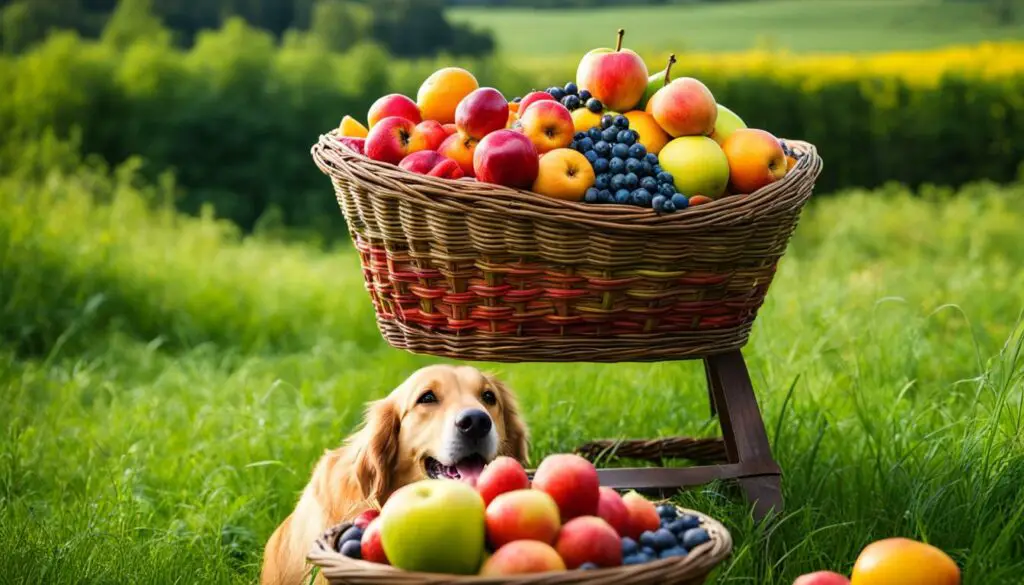
Protecting Your Pet’s Health
When it comes to keeping your furry friend safe from grape toxicity, prevention is key. By taking a few simple steps, you can minimize the risk of your dog ingesting grapes and experiencing potential health complications. Here are some tips to ensure your pet’s safety around grapes:
- Keep grapes and grape-containing products out of reach: Store grapes, raisins, grape juice, and currants in a secure place where your dog cannot access them. Remember, dogs are curious creatures and can easily snatch a tasty treat when you least expect it.
- Check food ingredients: Before sharing any human food with your dog, always check the ingredients for grapes or grape juice. Some foods, such as certain salads, desserts, or sauces, may contain grapes as an unsuspected ingredient.
- Educate children: If you have children around who enjoy grapes, it’s important to teach them about the potential dangers that grapes pose to dogs. Remind them to be cautious and avoid dropping grapes on the floor where your dog could easily gobble them up.
By implementing these preventive measures, you can significantly reduce the chances of grape toxicity in your beloved pet. However, accidents can still happen, so it’s essential to be prepared and know what to do if your dog ingests a grape, even if it’s just one.

Why Are Grapes Toxic for Dogs?
Grapes are known to be highly toxic to dogs, but the exact reason behind this toxicity is still not fully understood. Researchers speculate that substances like tartaric acid or mycotoxin produced by mold or fungus may be responsible for the adverse effects of grapes on dogs. These compounds can lead to severe health problems, including kidney damage and failure, in canines.
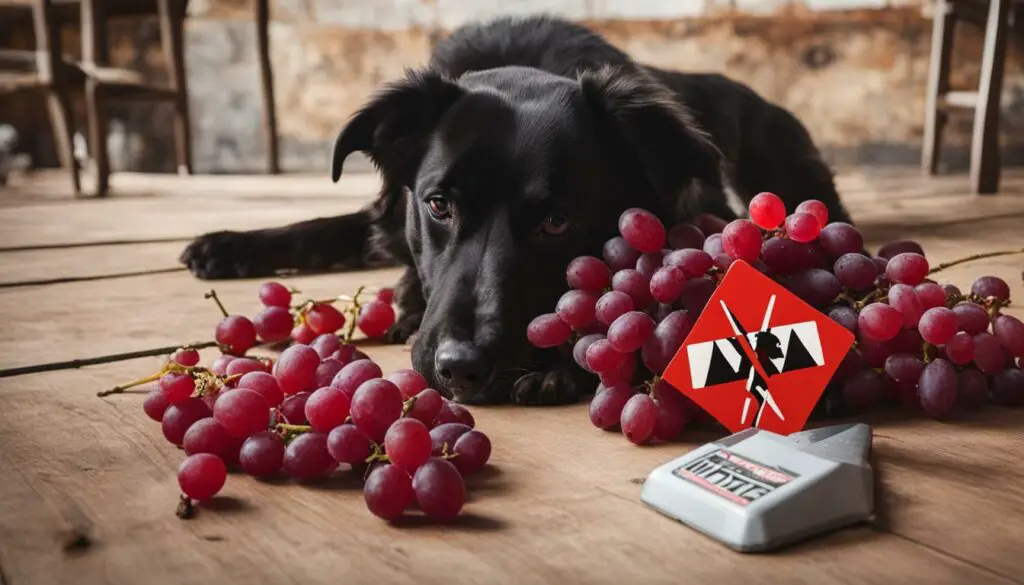
All types of grapes, including red, green, purple, seeded, and seedless varieties, as well as grape juice, wine, raisins, and currants, are considered toxic to dogs. It is important for dog owners to be aware of this and take preventive measures to ensure the safety of their furry companions.
To protect your dog from grape toxicity, it is crucial to keep grapes and grape-containing products out of their reach. This includes storing grapes in a secure location and being cautious about sharing human food that contains grapes. Educating children about the dangers of grapes for dogs can also help to prevent accidental ingestion.
What to Do If Your Dog Ate One Grape
If your dog has ingested a grape, immediate action is crucial to prevent potential kidney damage and failure. Here’s a step-by-step guide on what to do:
- Contact your veterinarian or a pet poison helpline: Reach out to a professional for guidance on the best course of action. They will provide specific instructions based on your dog’s size, breed, and overall health.
- Monitor for symptoms: Keep a close eye on your dog for any signs of grape poisoning, such as loss of appetite, vomiting, diarrhea, weakness, or increased urination. Note down any changes in behavior or health.
- Induce vomiting (if advised by a professional): In some cases, your veterinarian may suggest inducing vomiting to remove the grape from your dog’s system. However, do not attempt this without proper guidance, as it can be dangerous if done incorrectly.
- Seek veterinary care: Depending on the severity of the situation, your veterinarian may recommend bringing your dog in for a thorough examination and further treatment. They will evaluate the potential risks and take appropriate measures to protect your dog’s health.
Remember, time is of the essence when dealing with grape ingestion in dogs. Acting promptly and seeking professional advice can help prevent serious complications and ensure the best possible outcome for your furry friend.
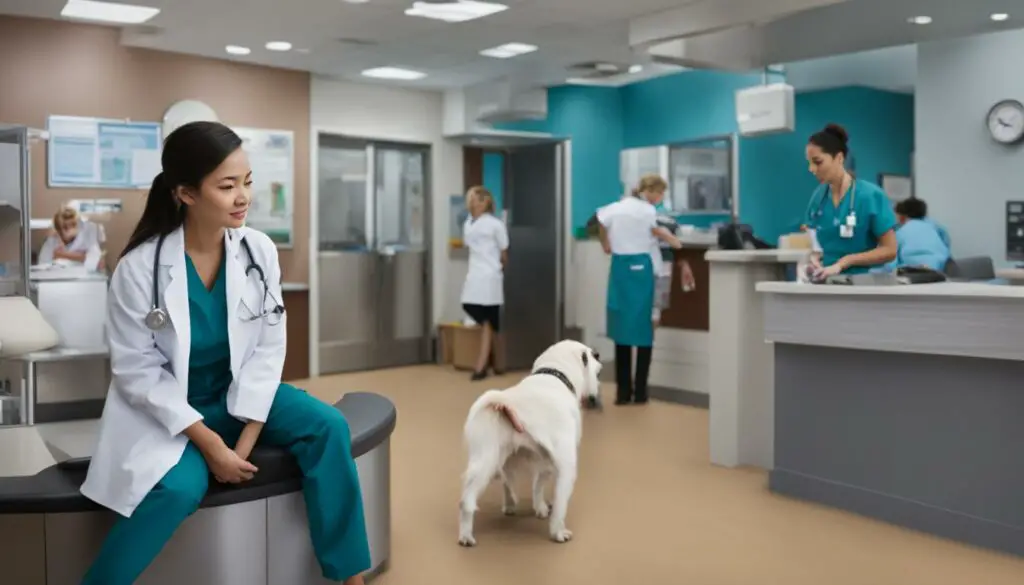
Signs of Grape Poisoning in Dogs
If your dog has ingested grapes or grape-containing products, it is important to be aware of the signs of grape poisoning. Dogs can exhibit various symptoms that indicate the toxic effects of grapes on their system. Prompt recognition of these signs can help you seek immediate veterinary attention and potentially save your pet’s life.
Some common signs of grape poisoning in dogs include:
- Loss of appetite
- Drinking a lot initially
- Diarrhea
- Vomiting
- Abdominal pain
- Weakness
- Lethargy
- Bad breath
- Increased urination followed by decreased urine production
- Dehydration
These symptoms typically appear within 12 to 24 hours after ingestion of grapes or grape-containing products. If you observe any of these signs in your dog, it is crucial to contact your veterinarian immediately or visit a 24/7 animal hospital for immediate treatment.
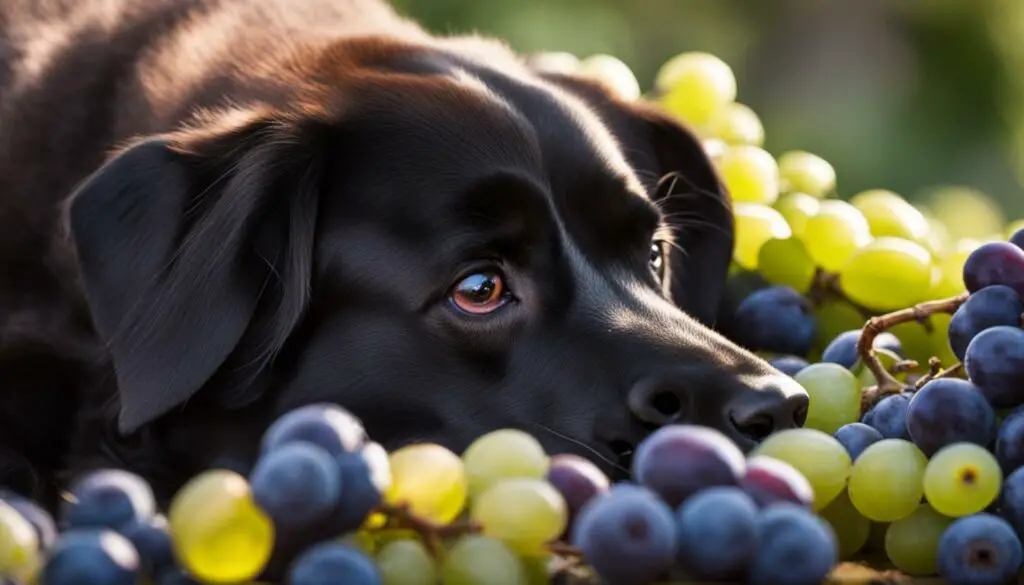
If you notice any of these signs in your dog, it is crucial to contact your veterinarian immediately or visit a 24/7 animal hospital for immediate treatment.
How Your Vet Will Treat Grape Poisoning
When it comes to treating grape ingestion in dogs, immediate veterinary attention is crucial. The treatment aims to prevent kidney problems and restore any lost kidney function. Depending on the severity of the poisoning, your veterinarian may employ various methods to address the situation effectively.
One common approach is inducing vomiting to remove any remaining grapes or grape fragments from the dog’s stomach. This can be done using medications specifically designed for this purpose. Additionally, activated charcoal may be administered to prevent further absorption of toxins into the bloodstream.
Fluid therapy is another important aspect of treatment for grape poisoning. It helps protect the kidneys and flush out any toxins that may have entered the bloodstream. Your veterinarian will carefully monitor your dog’s hydration levels and administer fluids accordingly.
If your veterinarian determines that immediate action is required and you are unable to reach a veterinary clinic right away, they may recommend administering a hydrogen peroxide solution at home to induce vomiting. However, it is crucial to consult with your veterinarian before attempting any home treatment.
| Treatment Methods for Grape Poisoning |
|---|
| Inducing vomiting |
| Administering activated charcoal |
| Fluid therapy to protect the kidneys |
“Immediate veterinary attention is crucial when it comes to treating grape ingestion in dogs. The treatment methods typically involve inducing vomiting, administering activated charcoal, and providing fluid therapy to protect the kidneys.”
It is important to note that treatment for grape poisoning should be performed by a qualified veterinarian. They have the knowledge and expertise to determine the appropriate course of action based on your dog’s individual situation. Seeking professional medical help ensures the best possible outcome and minimizes the risk of complications.
Remember, prevention is always better than cure. Keeping grapes and grape-containing products out of reach of your dog is essential. Educating yourself, your family, and your children about the dangers of grapes for dogs can also help prevent accidental ingestion. By taking proactive measures, you can safeguard your pet’s health and well-being.
Preventing Grape Poisoning in Dogs
Grapes and grape-containing products are highly toxic to dogs and can cause serious health complications, including kidney damage and failure. As a responsible pet owner, it is crucial to take steps to prevent grape toxicity and keep your furry friend safe. By following these preventive measures, you can reduce the risk of your dog ingesting grapes:
- Keep grapes out of reach: Store grapes, raisins, grape juice, and currants in a secure place where your dog cannot access them. Avoid leaving them on countertops, tables, or any other accessible areas.
- Check food ingredients: Always check the labels of food items before sharing them with your dog. Be vigilant for any mention of grapes or grape juice in the ingredients list.
- Teach children about the dangers: Educate your children about the potential hazards of grapes for dogs. Caution them not to leave grapes on the floor or feed them to the dog, as accidental ingestion can occur.
Implementing these preventive measures can significantly reduce the risk of grape poisoning in your dog. However, it is essential to remain vigilant and seek immediate veterinary attention if your dog accidentally ingests grapes or shows any signs of grape poisoning. Remember, prevention is always better than treatment when it comes to protecting your pet’s health and well-being.
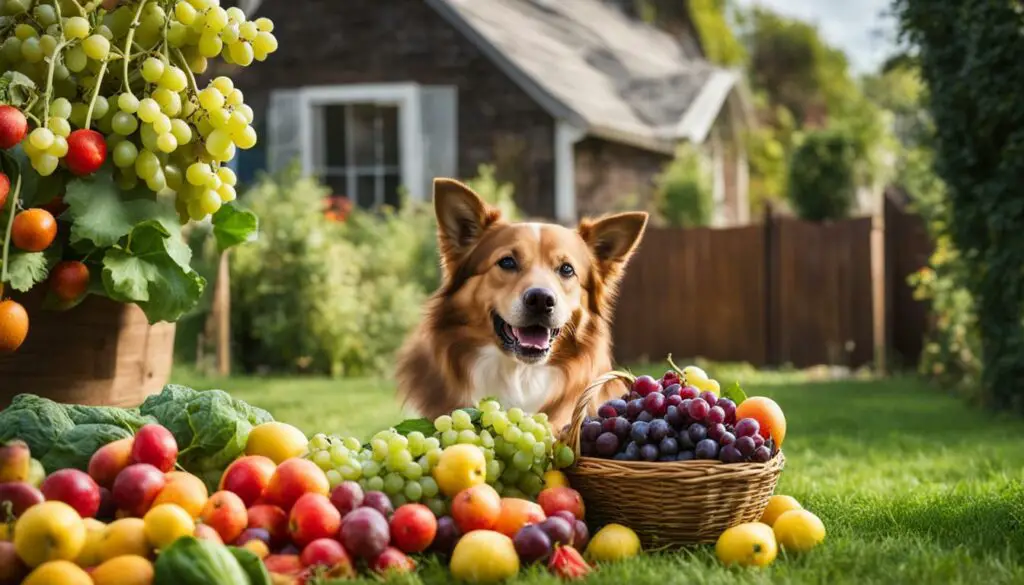
By taking these steps and being proactive in keeping grapes away from your dog, you can create a safe environment and prevent the potential dangers of grape toxicity. Remember, it only takes a small amount of grapes to cause harm to your beloved pet, so any ingestion should be taken seriously. Stay informed, stay vigilant, and prioritize your dog’s health and safety.
Conclusion
My dog ate a grape, and I quickly learned the importance of preventing grape toxicity in dogs. Grapes are highly toxic to our canine companions, and even a single grape can lead to kidney damage and failure. That’s why it’s crucial to take immediate action if your dog ingests a grape.
Prevention is key when it comes to protecting our pets’ health. By keeping grapes and grape-containing products out of reach, checking food ingredients for grapes, and educating children about the dangers, we can minimize the risk of accidental ingestion. It’s also important to seek immediate veterinary attention or contact a pet poison helpline if your dog eats a grape.
Remember, our furry friends rely on us to keep them safe. By being proactive and informed, we can prevent potential complications and ensure the well-being of our beloved dogs. Let’s prioritize grape toxicity prevention to keep our four-legged companions healthy and happy.
FAQ
Why are grapes toxic to dogs?
The exact reason for grape toxicity in dogs is still unknown, but substances like tartaric acid or mycotoxin produced by mold or fungus may be responsible. Grapes contain various compounds that can cause health problems in dogs, potentially leading to kidney damage and failure.
What should I do if my dog ate one grape?
If your dog ate even a single grape, it is recommended to contact your veterinarian or a pet poison helpline for guidance. They may advise monitoring for symptoms or inducing vomiting to prevent absorption of the toxins. It is important to seek professional advice to avoid potential kidney damage and failure.
What are the signs of grape poisoning in dogs?
Symptoms of grape poisoning in dogs include loss of appetite, vomiting, diarrhea, weakness, increased urination, and dehydration. These signs usually appear between 12 to 24 hours after ingestion. If you notice any of these symptoms in your dog, contact your veterinarian immediately or visit a 24/7 animal hospital for immediate treatment.
How will my vet treat grape poisoning in my dog?
If your dog is diagnosed with grape poisoning, your veterinarian will aim to prevent kidney problems and restore any lost kidney function. Treatment may involve inducing vomiting, administering activated charcoal, and providing fluid therapy to protect the kidneys. It is important to consult with a veterinarian before taking any action at home.
How can I prevent grape poisoning in my dog?
To prevent grape poisoning, keep grapes, raisins, grape juice, and currants in a safe place where dogs cannot reach them. Check food ingredients for grapes before sharing any human food with your dog. Educate children about the dangers of grapes for dogs to prevent accidental ingestion.
Can dogs recover from eating grapes?
The outcome of grape ingestion in dogs can vary. If a small amount of grapes was ingested and immediate treatment was provided, the dog may recover without displaying symptoms. However, if kidney damage and failure occur, the chances of recovery may be slim. Seeking veterinary attention as soon as possible maximizes the chances of a favorable outcome.
What other foods are toxic to dogs?
Other foods that can be toxic to dogs include onions, chocolate, garlic, alcohol, cocoa, macadamia nuts, foods with xylitol, and more. It is important for dog owners to be aware of these foods and keep them out of reach of dogs.
What fruits can dogs eat?
Some fruits that dogs can eat in moderation include apples (without the seeds), bananas, blueberries, pineapple, strawberries, watermelon, cranberries, and more. Monitor your dog’s reaction and offer fruits in limited amounts. Remove any seeds and avoid fruits that are high in sugar for a balanced diet.
How can I protect my pet’s health?
You can protect your pet’s health by being proactive in preventing grape toxicity. Keep grapes and grape-containing products out of reach of dogs, check food ingredients, and educate children about the dangers. Prompt action and seeking veterinary attention if a dog ingests grapes can prevent complications and ensure your pet’s well-being.

